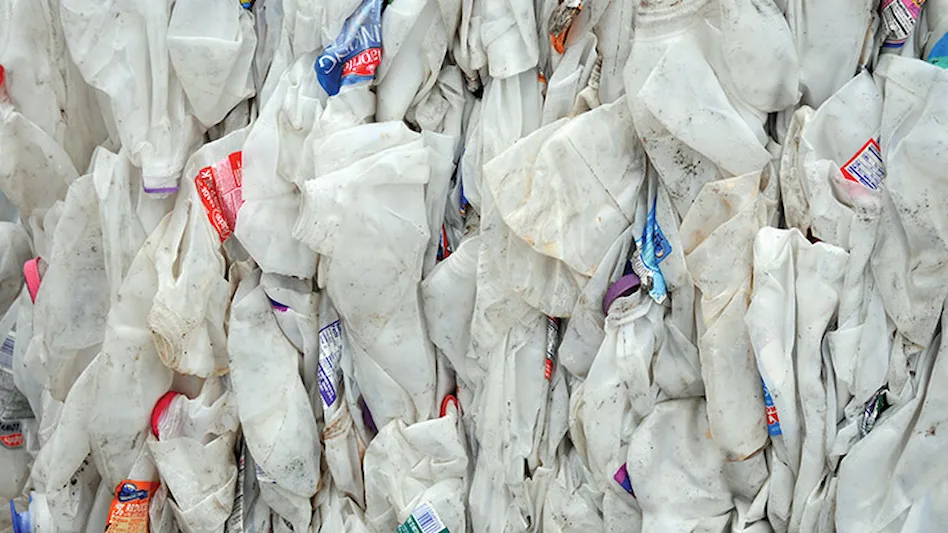
Photo: Shutterstock
The 2015 U.S. plastic bottle recycling rate posted a slight decrease of 0.5 percent compared with 2014, according to figures released by the Association of Plastic Recyclers (APR) and the American Chemistry Council (ACC) in the 26th annual “National Post-Consumer Plastics Bottle Recycling Report,” available at https://plastics.americanchemistry.com/2015-United-States-National-Postconsumer-Plastic-Bottle-Recycling-Report.pdf. The overall U.S. recycling rate for plastic bottles in 2015 was 31.1 percent, down slightly from 31.7 percent the previous year, according to the report.
Since 2010 plastic bottle recycling has grown by nearly 400 million pounds, increasing on average by nearly 80 million pounds per year, or 2.9 percent annually, the ACC and APR say.
Following 25 consecutive years of growth, several factors contributed to the recent plateau, the associations say, including a decline in material collected for recycling, reduced exports and increased contamination of recyclables. In addition, use of plastic bottles in packaging applications continued to expand but was offset by lightweighting and increased use of concentrates with smaller, lighter bottles.
In 2015, polyethylene terephthalate (PET) recycling decreased by 15 million pounds, while collection of high-density polyethylene (HDPE) bottles, which includes bottles for milk, household cleaners and detergents, dipped slightly by 0.4 percent, or 4.8 million pounds, at just over 1.1 billion pounds for the year. The recycling rate for HDPE bottles declined 0.4 percent to 34.4 percent.
Domestic processing of recycled HDPE continued to grow for the fifth consecutive year, according to the report. Domestic reclaimers processed more than 1 billion pounds in 2015, an increase of 4.4 percent. Total domestic capacity to process postconsumer HDPE grew to 1.46 billion pounds, with reclaimers continuing to use assets to process nonbottle HDPE and polypropylene (PP).
Exports of HDPE fell 16 percent to 184 million pounds, while imports rose by 25 percent to nearly 66 million pounds. Given steady domestic collection, these trends resulted in U.S. reclamation plants purchasing nearly 44 million pounds in additional material, the report notes. Domestic reclaimers purchased more than 1 billion pounds of postconsumer HDPE for the year.
“The plastics recycling industry has a history of growth that spans a quarter century and has weathered many factors,” says Steve Alexander, executive director of APR. “As a result of expanded infrastructure and demand, this industry remains well-positioned for long-term growth.”
Steve Russell, ACC vice president of plastics, says, “All of us should remain diligent in recycling our plastics. Putting the right materials into the bin helps make processing more efficient, which supports the long-term growth and stability of plastics recycling.”
This year’s survey also found the collection of PP bottles rose nearly 20 percent to reach 32 million pounds, with the PP collection rate increasing to nearly 18 percent. PP caps, closures and nonbottle containers are widely collected for recycling in the United States, and these data are presented in a separate report on recycling nonbottle rigid plastics, which will be released in the coming months.
PET and HDPE bottles combined make up 97 percent of the U.S. market for plastic bottles, with PP comprising 1.8 percent, low-density polyethylene (LDPE) representing 0.8 percent and polyvinyl chloride (PVC) representing 0.3 percent, the report states.
The 2015 report reflects minor corrections in methodology for PP and HDPE in 2104 and 2015, the ACC and APR note. Details on the corrections are provided in the introduction.
Data on PET recycling referenced in the report were separately funded and published by APR and the National Association for PET Container Resources (NAPCOR). A separate report, “Report on PET Container Recycling Activity in 2015,” is available on APR’s website at www.plasticsrecycling.org/images/pdf/resources/reports/APR_NAPCOR_2015RateReportFINAL.pdf.
The 2015 United States National Postconsumer Plastic Bottle Recycling Report is based on a survey of reclaimers conducted by Moore Recycling Associates Inc. of Sonoma, California.
Resources for municipal recyclers are available at www.recycleyourplastics.org and at www.plasticsrecycling.org. An informational webinar about the report will be held Monday, Nov. 7, at 1 p.m. EST. Those interested in attending can register at https://attendee.gotowebinar.com/register/8457610939930067457.